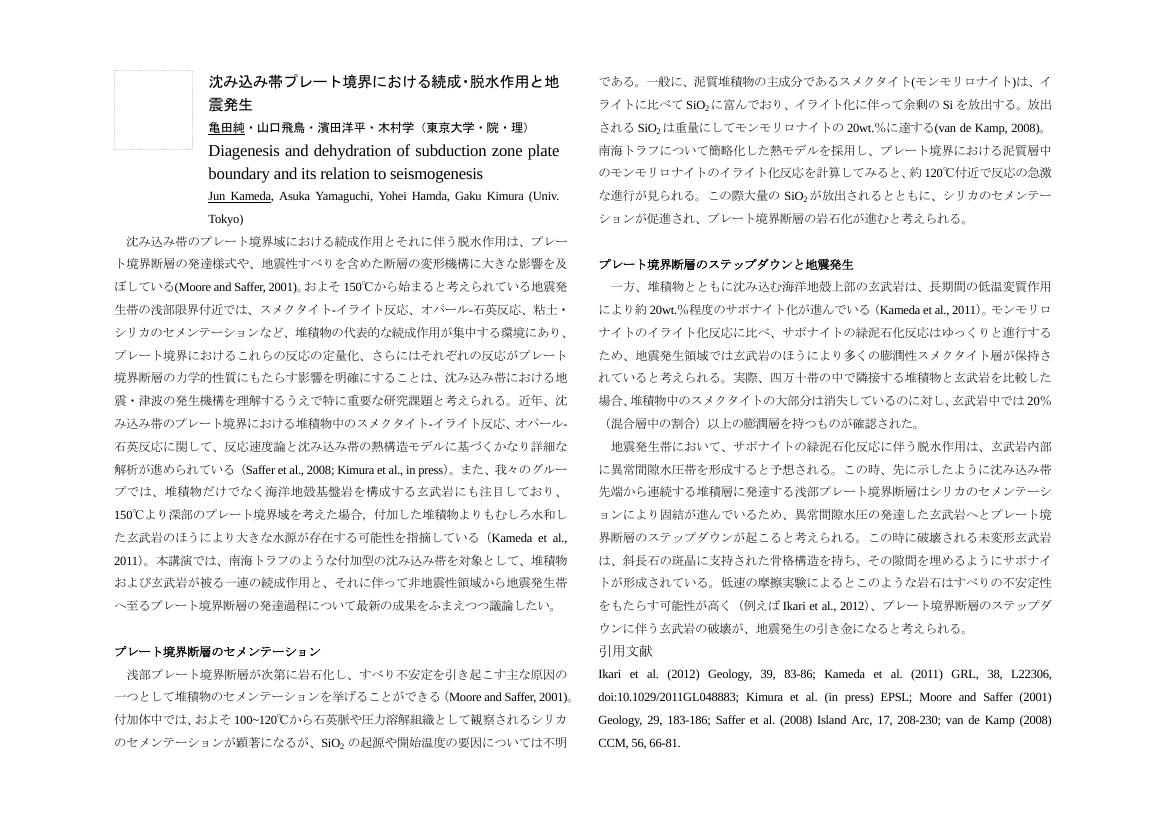2 0 0 0 OA プレート境界断層超深度掘削・観測による南海トラフ巨大地震切迫度評価
本研究では、これまで紀伊半島沖熊野灘において実施されてきた南海トラフ地震発生帯掘削研究(超深度掘削は海底下約3,000mまで掘削済みでプレート境界断層まで残り約2,200m)の総仕上げとして、プレート境界断層貫通掘削までの掘削時孔内検層、孔内設置受振器による3次元鉛直地震探査、断層試料の摩擦実験、近傍からの繰り返し周回地震探査を実施する。もって断層上盤の応力場・主応力と間隙水圧、プレート境界断層の摩擦強度を解明し、それらを総合して地震・津波発生切迫度を定量的に評価することを目的とする。第2年度は、これまでの掘削によって得られたデータをまとめ上げ、モデル化し、上盤プレート上部の応力場、間隙水圧を解明した。概要は以下の通りである。1)3次元反射法データの最新技術による再解析。特に地震発生プレート境界断層から分岐断層にかけて実施。詳細な構造の実態解明、速度構造の変化が予測された。2)既存データの解析、実験的分析の蓄積、完了。海底下3,000m下までの摩擦特性計測実験を完了し、深度方向の変化が予察的に得られた。3)掘削孔内に設置してあった圧力計などの回収を実施した。10年間の記録の回収に成功した。2016年4月1日には70年ぶりに起こった南海プレート境界地震の世界初の孔内観測に成功、結果の迅速な公開を実施した。4)最終的な科学掘削目標達成のための慎重な技術的検討を掘削実施主体である海洋研究開発機構と適宜進めた。
1 0 0 0 OA 沈み込み帯プレート境界における続成・脱水作用と地震発生
- 著者
- 亀田 純 山口 飛鳥 濱田 洋平 木村 学
- 出版者
- The Geological Society of Japan
- 雑誌
- 日本地質学会学術大会講演要旨 (ISSN:13483935)
- 巻号頁・発行日
- pp.65, 2012 (Released:2013-03-26)
1 0 0 0 OA プレート境界断層が海溝から地震発生深度にかけて発達する際の流体挙動
- 著者
- 氏家 恒太郎 山口 飛鳥 木村 学 久光 敏夫 平 朝彦
- 出版者
- 公益社団法人 東京地学協会
- 雑誌
- 地学雑誌 (ISSN:0022135X)
- 巻号頁・発行日
- vol.115, no.3, pp.353-366, 2006-06-25 (Released:2009-11-12)
- 参考文献数
- 34
- 被引用文献数
- 3 3
Fluid behavior during the evolution of the plate boundary fault (pbf) from a trench to seismogenic depths is the central problem when evaluating the relationship between fluids and seismicity in subduction zones. Ocean Drilling Program Legs 190 and 196 at the toe region of the Nankai accretionary margin reveal that fluid-filled dilatant fractures and underconsolidated underthrust sediments lead to an elevated fluid pressure in and below the pbf, respectively. The pbf with elevated fluid pressure extends down-dip to 35 km, resulting in the absence of seismic behavior at shallow depths and mechanical decoupling between accreted and underthrust sediments. Underconsolidated underthrust sediments are primarily caused by rapid tectonic loading compared to the rate of fluid escape in underthrust sediments and secondarily by a lowpermeability cap due to the compactively deformed pbf. Fluid-filled dilatant fractures represent the overconsolidate state within the pbf, which is caused by the generation of high fluid pressure after compactive deformations.The exhumed plate boundary rocks (i.e., tectonic melange) in the Shimanto accretionary complex indicate that the underthrust sediments became rocks due to dewatering, pressure solution, and other diagenetic reactions, thus acquiring elastic strength. The pbf in the upper part of the seismogenic depths was weak due to elevated fluid pressure, this facilitated the downward step of the pbf and the underplating of underthrust rocks. The pbf under low effective stress was unlikely to nucleate the instability; however the fluid-related repeated deformations, which probably reflect the seismic cycle in the subduction zone, could be recorded. The coseismic deformations were attributed to hydraulic implosion breccias, injection of ultracataclasite, and fluid inclusion stretching in the pbf. Implosion breccias suggest rapid depressurization associated with the passage of the rupture through dilational jog. Other deformations represent shear heating and fluidization along the narrow ultracataclasite layer, which could enhance the propagation of instability at the pbf in the upper parts of the seismogenic depths.
